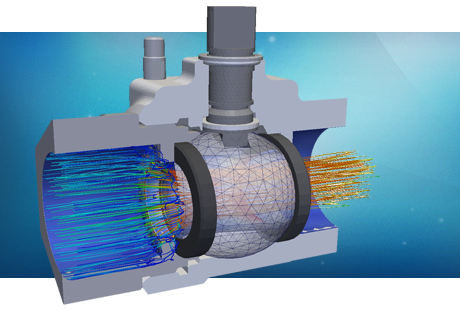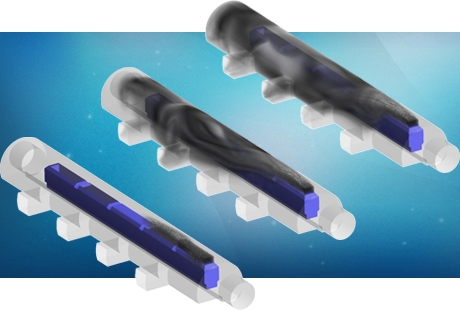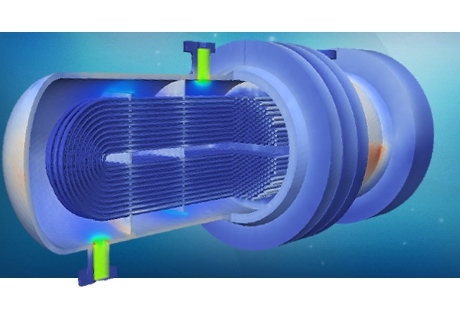FEA based design and analysis of subsea umbilicals
Background
Subsea umbilicals are essential components of the control system and safe operation of subsea production systems (SPS).
The design of subsea umbilicals requires careful balancing of the functionality with the structural requirements for reeling and deepwater installation. The installability of these subsea components is crucial.


Traditionally, the design and analysis of subsea umbilicals is performed via iterations of costly experimental studies, with questionable representation of in-place conditions, and 2D cross-section studies, which must use elaborate assumptions to model the torsional properties and longitudinal effects of the helical geometry.
Umbilical analysis
Whilst the value of practical testing cannot be replaced by simulation, the insight and potential fault identification capability of full 3D modelling is crucial in reducing the number of test iterations to a minimum and in providing the confidence that testing will yield positive results.
With the advancement of computational power and extensive experience in optimising modelling techniques, PRE Technologies can develop full 3D models of umbilical lengths that can be analysed for operation, installation and accidental load cases. This type of analysis allows better insight into the structural integrity or damage of each umbilical component as well as their interaction and relative deformation or slip.
The finite element analysis of umbilicals presents a number of challenges:
- The complex helical geometry can result in a large mesh and a computationally heavy model. With expert knowledge and an understanding of the numerical methods of FE, the problem size can be reduced to optimise the computational intensity of the project.
- The large number of contact surfaces and the changing stick-slip nature of the interactions produce numerous non-linearities and can lead to numerically unstable models. The experience accrued by PRE Technologies in simulations using explicit analysis is invaluable in solving these problems in a time-effective manner.
- The definition of an adequate model length, sufficient to capture all possible cross-section combinations and exclude end effects. Typically, a length greater than the outer bundle pitch length is required.
- Friction modelling with complex contact definitions can be challenging. By working in close collaboration with our clients, we can identify the most effective combination of friction coefficients to produce meaningful results.
- The definition of boundary conditions for a relatively short simulation length has a great impact on the modelling results. Model ends with realistic radial constraints and a sufficient length to exclude end effects is critical in determining the radial interaction between subcomponents.
Combining the analysis expertise with the computational tools developed, the structural and functional integrity of umbilicals can be verified under a variety of load conditions and analyses:
- Tension, pull-test or self-weight;
- Tensioner crush or emergency squeeze, including the determination of ovalisation and slippage of internal components;
- Installation, reeling and bending, including the determination of plastic deformation and ovality;
- Thermal analysis to ensure functionality of control fluid and limit material degradation;
- Fluid analysis (CFD) to determine fluid induced loading;
- Modal analysis to determine modes which may be excited by flow conditions (VIV);
- Determination of cross-section properties for use in dynamic analysis and installation analysis.
Example
This study focuses on the simulation of a case where the sample umbilical is held by the tensioners in the event of an emergency clamping. The umbilical is subjected to tension due to the self-weight of the laid portion as well as a radial crush force exerted by the tensioner tracks. A typical umbilical cross-section is modelled. The next figure shows the mesh for the subsea umbilical analysed in this work.

The risks associated with this emergency procedure are:
- Structural damage to components due to excessive crush; typically to stiffer components such as steel tubes or armour wire.
- Loss of functionality due to ovalisation of components (control fluid tubes) or structural damage to conductors (electrical and fibre-optic).
- Internal slip due to insufficient radial crush force.
This type of analysis is essential in determining an adequate tensioner capacity to ensure safe emergency operations and avoid costly damage to product and delays to the installation campaign.
Structural damage
The analysis is conducted in two steps. A tension, calculated based on the submerged weight of the laid portion of umbilical, is applied to the sample cross-section. The next figure presents the equivalent stress results for this geometry and load conditions, explained below in this article.

The tensioner pads, modelled on tensioner track geometry (160° angle) are pressed radially into the umbilical. The radial reaction force is monitored and, when the desired tensioner crush force is reached, the analysis is stopped.
This type of analysis produces a vast amount of information on the deformation and stress distribution within the umbilical and the interaction between its subcomponents. The equivalent stress results confirm that the higher stresses are seen by the stiffer steel tubes. The next two figures show how this information can be broken down to analyse components individually, ensuring there is no loss of functionality in the electrical conductors or control fluid tubes.


Internal slip resistance
Another part of the analysis is to verify that the tensioner applies sufficient clamp force to the umbilical to resist slipping and that this force is transmitted through the components to the innermost bundle. The next two figures show plots of normal stress, on the outer surfaces (left hand side) of the sheath containing the outer and inner bundles (right hand side).


The radial crush force can be determined and the analysis stopped when the desired value (270 Te in this case) is reached, as shown in the next plot. The resulting frictional resistance can then be compared to the axial force applied to each bundle and eventual slippage is identified.

In the current example, with a water depth of 1000 m, 52 Te of submerged weight act axially on the umbilical. Thus, with the friction factor between the pads and the sheaths at 0.2, the resistance to slip at the outer surface is 54 Te, just about sufficient to prevent slippage of the umbilical.
However, at the inner bundle, the normal clamping force is only 5.4 Te and the friction coefficient at this interface is 0.3, resulting in a slip resistance of 1.62 Te. This value is not sufficient to resist the portion of the axial load to which the inner bundle is subjected (8.1 Te). Thus, in the current configuration, the inner bundle would sustain significant slippage and the umbilical would fail under an emergency squeeze.
It is thus necessary to revisit the umbilical design and aim for a more efficient transmission of radial loads. Additionally, it would be advisable to increase the tensioner emergency clamping force in order to ensure a safety margin on the overall slip resistance.
Ovality determination
Finally, a measure of the plastic strain, as shown in the next figure, is useful for the determination of locations where residual ovality is going to be significant.

By selecting hot spots of plastic deformation, local ovalisation measurements can be taken to ensure compliance with the maximum ovality acceptance criteria.
Benefits
PRE Technologies possess the required experience and computational tools to perform a full assessment of subsea umbilicals and cables, under a wide range of load conditions.
The main benefit of these 3D computational approaches to analysis is the greater insight into local and large-scale issues which may arise in the installation and operation of cost intensive and safety critical components.
Please see other related articles and case studies available at the PRE Technologies website. We are constantly updating our website and aim to have a wider range of case studies in the future, so do keep in touch.
Keep your curiosity in good shape.
For more information on this or any other technical white paper, please contact us.







